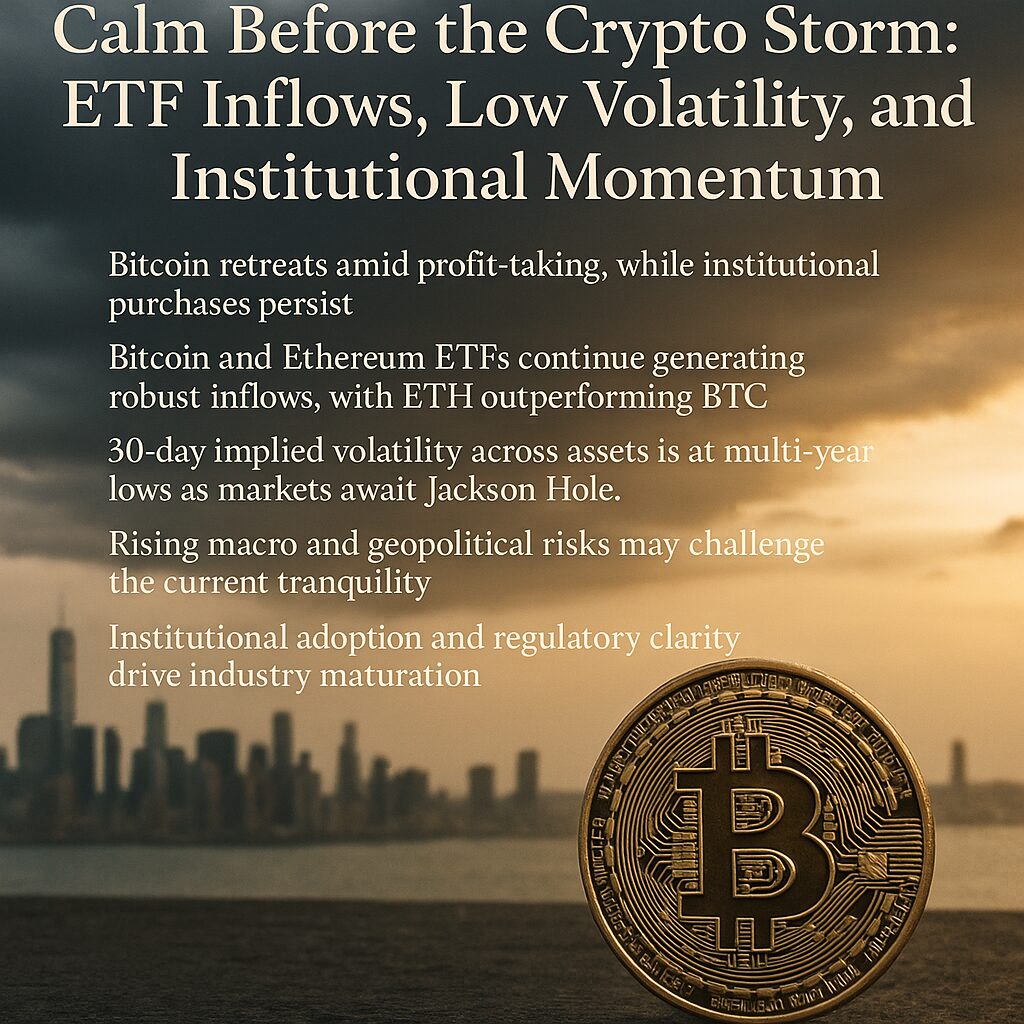
Main Points:
- Bitcoin retreats amid profit-taking, while institutional purchases persist.
- Bitcoin and Ethereum ETFs continue generating robust inflows, with ETH outperforming BTC.
- 30-day implied volatility across assets is at multi-year lows as markets await Jackson Hole.
- Rising macro and geopolitical risks may challenge the current tranquility.
- Institutional adoption and regulatory clarity drive industry maturation.
1. Bitcoin Profit-Taking Amid ETF Strength
Bitcoin currently trades around $115,000, down approximately 0.9% yesterday, reflecting a $1 K pullback from recent highs driven by personal investors cashing in on gains. Meanwhile, ETF-driven institutional demand remains strong—Bitcoin ETFs have favored two consecutive weeks of inflows in August, with roughly $540 million entering in the second week. Ethereum ETFs have outpaced even that: a record $2.85 billion flowed in during the same period, far exceeding BTC’s figures.
Despite a temporary high near $124,000, Bitcoin now hovers around $118,000, representing a 27% year-to-date gain. Ethereum shows similar strength, up about 25% over the past month, currently trading at approximately $4,537.
This dynamic illustrates a dichotomy: retail investors are cashing out, while institutional capital continues to reinforce crypto’s infrastructure.
2. Volatility Suppression Ahead of Jackson Hole
Market volatility has collapsed across industries as investors await the Federal Reserve’s Jackson Hole speech (August 21–23). Bitcoin’s 30-day implied volatility has dropped to roughly 36%, its lowest in two years. Similarly, gold (GVZ), Treasuries (MOVE index), and equities (VIX) have all recorded significant declines. Markets are positioned for clarity on interest rate direction, with the prevailing theory that the Fed will resume rate cuts—possibly as early as September.
This sharp volatility compression signals fading fear—but analysts caution this could be a case of “the quiet before the storm”.
3. Macro and Geopolitical Risk—A Ticking Clock
Beneath the current calm lies a web of risk. Geopolitical tensions are rising: Trump–Zelenskyy meetings and worsening relations with Russia loom large. Domestically, inflation refuses to fully retreat—July’s US Producer Price Index rose 3.3%, surpassing estimates. Goldman Sachs analysts warn clients to hedge against potential growth shocks, unraveling disinflationary pressures, and threats to the Fed’s independence. The present stillness may be misleading.
4. Institutional Momentum & Rising Market Maturity
Broader trends underscore crypto’s growing institutional acceptance. Q1 2025 institutional crypto investments reached $21.6 billion, while global crypto market capitalization has exceeded $4 trillion. BlackRock-managed crypto products alone have surpassed $100 billion in assets under management, largely due to ETF inflows.
In Q2, Ethereum ETFs notably outperformed Bitcoin ones: $3 billion in ETH inflows vs. only $178 million for BTC, underscoring shifting preferences toward assets with utility, yield, and regulatory clarity. This pivot positions ETH not just as “digital silver” but a leading Web3 investment.
Hedge funds are benefiting too—Tephra Digital logged a 9% return in July, bringing YTD gains to 23%, aided by crypto’s broader surge and ETF excitement. Meanwhile, Bitcoin mining profitability rose about 2% in July as BTC prices climbed 7% and network hashrate grew.
5. Summary Overview
| Theme | Key Insights |
|---|---|
| Bitcoin Market Dynamics | Retail profit-taking; institutional ETF buying persists |
| Volatility Environment | Near-term calm ahead of Jackson Hole; implied volatility at multi-year lows |
| Risk Landscape | Inflation pressures and geopolitical unrest pose latent threats |
| Institutional Trends | ETF inflows, institutional allocations, and ETH momentum mark crypto’s maturing role |
Conclusion
Bitcoin’s mid-$115K level belies two simultaneous narratives: retail investors de-risking profits and institutions deepening their crypto exposure through ETFs—especially Ethereum. Markets have adopted a “wait-and-see” mode, anticipating clarity from the Fed’s upcoming Jackson Hole remarks. Yet, the low-volatility environment may be misleading, given persistent macroeconomic and geopolitical threats. The crypto market is evolving from speculative frontier to structured, institutionalized market; your next opportunity may lie not just in new tokens, but decoding institutional flows and the rising utility of smart contracts and Ethereum protocols in enterprise contexts.

